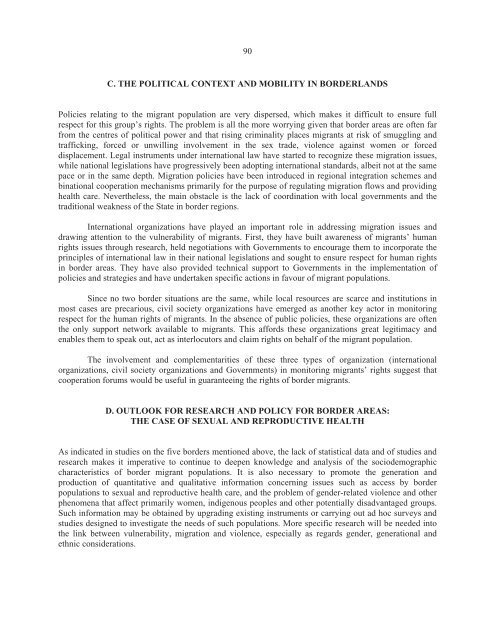Population, territory and sustainable development
The purpose of this document is to provide an overview of current trends, contexts and issues in the spheres of population, territory and sustainable development and examine their public policy implications. Three themes run through the report. The first two are laid out in the empirical chapters (III through X); the third is taken up in the closing chapter. Using the most recent data available (including censuses conducted in the 2010s), the first theme describes and tracks location and spatial mobility patterns for the population of Latin America, focusing on certain kinds of territory. The second explores the linkages between these patterns and sustainable development in different kinds of territory in Latin America and the Caribbean. The third offers considerations and policy proposals for fostering a consistent, synergistic relationship between population location and spatial mobility, on the one hand, and sustainable development, on the other, in the kinds of territory studied.
The purpose of this document is to provide an overview of current trends, contexts and issues in the spheres of population, territory and sustainable development and examine their public policy implications. Three themes run through the report. The first two are laid out in the empirical chapters (III through X); the third is taken up in the closing chapter. Using the most recent data available (including censuses conducted in the 2010s), the first theme describes and tracks location and spatial mobility patterns for the population of Latin America, focusing on certain kinds of territory. The second explores the linkages between these patterns and sustainable development in different kinds of territory in Latin America and the Caribbean. The third offers considerations and policy proposals for fostering a consistent, synergistic relationship between population location and spatial mobility, on the one hand, and sustainable development, on the other, in the kinds of territory studied.
Create successful ePaper yourself
Turn your PDF publications into a flip-book with our unique Google optimized e-Paper software.
90<br />
C. THE POLITICAL CONTEXT AND MOBILITY IN BORDERLANDS<br />
Policies relating to the migrant population are very dispersed, which makes it difficult to ensure full<br />
respect for this group’s rights. The problem is all the more worrying given that border areas are often far<br />
from the centres of political power <strong>and</strong> that rising criminality places migrants at risk of smuggling <strong>and</strong><br />
trafficking, forced or unwilling involvement in the sex trade, violence against women or forced<br />
displacement. Legal instruments under international law have started to recognize these migration issues,<br />
while national legislations have progressively been adopting international st<strong>and</strong>ards, albeit not at the same<br />
pace or in the same depth. Migration policies have been introduced in regional integration schemes <strong>and</strong><br />
binational cooperation mechanisms primarily for the purpose of regulating migration flows <strong>and</strong> providing<br />
health care. Nevertheless, the main obstacle is the lack of coordination with local governments <strong>and</strong> the<br />
traditional weakness of the State in border regions.<br />
International organizations have played an important role in addressing migration issues <strong>and</strong><br />
drawing attention to the vulnerability of migrants. First, they have built awareness of migrants’ human<br />
rights issues through research, held negotiations with Governments to encourage them to incorporate the<br />
principles of international law in their national legislations <strong>and</strong> sought to ensure respect for human rights<br />
in border areas. They have also provided technical support to Governments in the implementation of<br />
policies <strong>and</strong> strategies <strong>and</strong> have undertaken specific actions in favour of migrant populations.<br />
Since no two border situations are the same, while local resources are scarce <strong>and</strong> institutions in<br />
most cases are precarious, civil society organizations have emerged as another key actor in monitoring<br />
respect for the human rights of migrants. In the absence of public policies, these organizations are often<br />
the only support network available to migrants. This affords these organizations great legitimacy <strong>and</strong><br />
enables them to speak out, act as interlocutors <strong>and</strong> claim rights on behalf of the migrant population.<br />
The involvement <strong>and</strong> complementarities of these three types of organization (international<br />
organizations, civil society organizations <strong>and</strong> Governments) in monitoring migrants’ rights suggest that<br />
cooperation forums would be useful in guaranteeing the rights of border migrants.<br />
D. OUTLOOK FOR RESEARCH AND POLICY FOR BORDER AREAS:<br />
THE CASE OF SEXUAL AND REPRODUCTIVE HEALTH<br />
As indicated in studies on the five borders mentioned above, the lack of statistical data <strong>and</strong> of studies <strong>and</strong><br />
research makes it imperative to continue to deepen knowledge <strong>and</strong> analysis of the sociodemographic<br />
characteristics of border migrant populations. It is also necessary to promote the generation <strong>and</strong><br />
production of quantitative <strong>and</strong> qualitative information concerning issues such as access by border<br />
populations to sexual <strong>and</strong> reproductive health care, <strong>and</strong> the problem of gender-related violence <strong>and</strong> other<br />
phenomena that affect primarily women, indigenous peoples <strong>and</strong> other potentially disadvantaged groups.<br />
Such information may be obtained by upgrading existing instruments or carrying out ad hoc surveys <strong>and</strong><br />
studies designed to investigate the needs of such populations. More specific research will be needed into<br />
the link between vulnerability, migration <strong>and</strong> violence, especially as regards gender, generational <strong>and</strong><br />
ethnic considerations.


















